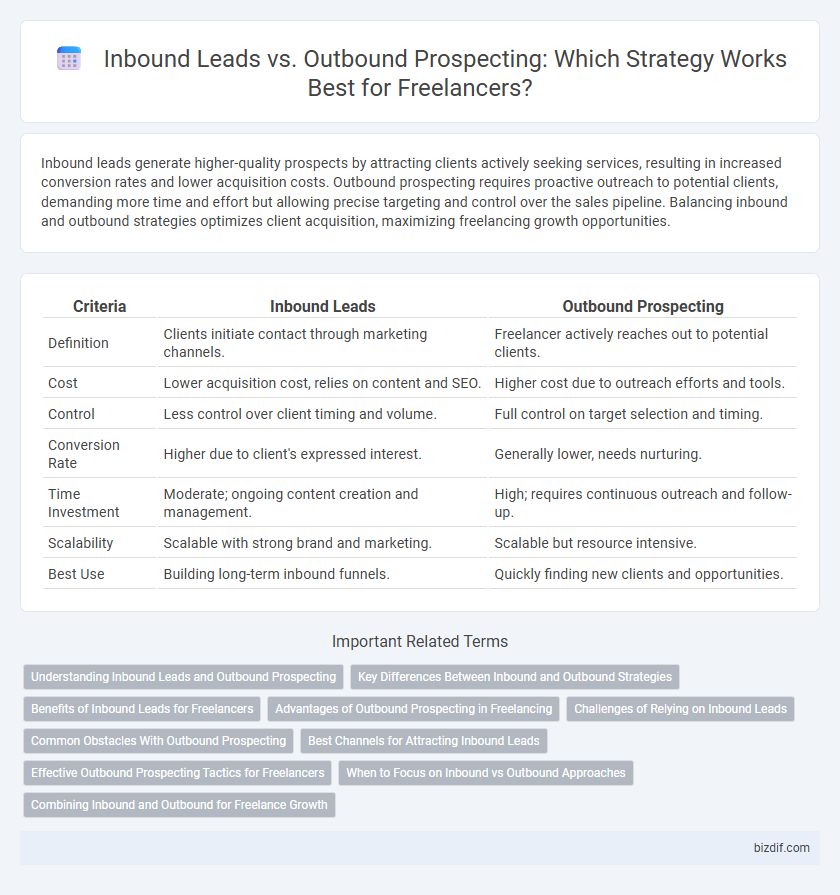Inbound leads generate higher-quality prospects by attracting clients actively seeking services, resulting in increased conversion rates and lower acquisition costs. Outbound prospecting requires proactive outreach to potential clients, demanding more time and effort but allowing precise targeting and control over the sales pipeline. Balancing inbound and outbound strategies optimizes client acquisition, maximizing freelancing growth opportunities.
Table of Comparison
| Criteria | Inbound Leads | Outbound Prospecting |
|---|---|---|
| Definition | Clients initiate contact through marketing channels. | Freelancer actively reaches out to potential clients. |
| Cost | Lower acquisition cost, relies on content and SEO. | Higher cost due to outreach efforts and tools. |
| Control | Less control over client timing and volume. | Full control on target selection and timing. |
| Conversion Rate | Higher due to client's expressed interest. | Generally lower, needs nurturing. |
| Time Investment | Moderate; ongoing content creation and management. | High; requires continuous outreach and follow-up. |
| Scalability | Scalable with strong brand and marketing. | Scalable but resource intensive. |
| Best Use | Building long-term inbound funnels. | Quickly finding new clients and opportunities. |
Understanding Inbound Leads and Outbound Prospecting
Inbound leads refer to potential clients who actively seek out freelancers through channels like referrals, organic search, or social media engagement, indicating higher interest and often leading to quicker conversions. Outbound prospecting involves proactively reaching out to potential clients via cold emails, calls, or networking, requiring targeted research and personalized messaging to capture attention. Effective freelancing growth leverages a balance of inbound lead nurturing for sustained interest and outbound prospecting to expand opportunities in competitive markets.
Key Differences Between Inbound and Outbound Strategies
Inbound leads are generated through content marketing, SEO, and social media engagement, attracting clients who actively seek freelance services. Outbound prospecting involves direct outreach via cold emails, calls, or networking to identify and engage potential clients proactively. Key differences include the level of client initiation, cost efficiency, and scalability, with inbound focusing on pull marketing and outbound on push marketing tactics.
Benefits of Inbound Leads for Freelancers
Inbound leads generate higher-quality clients for freelancers by attracting prospects already interested in their skills or services, leading to increased conversion rates. This approach reduces time spent on cold outreach, allowing freelancers to focus on delivering value and refining their craft. Freelancers benefit from sustained business growth and enhanced reputation through organic referrals and repeat clients sourced via inbound methods.
Advantages of Outbound Prospecting in Freelancing
Outbound prospecting in freelancing enables targeted outreach to specific niches or clients, accelerating client acquisition and increasing the chances of landing high-value projects. This proactive approach allows freelancers to control their pipeline by directly engaging decision-makers instead of waiting passively for inbound leads, which can be inconsistent. Leveraging tools like LinkedIn, cold emailing, and personalized pitches significantly expands opportunities beyond the limitations of relying solely on inbound inquiries.
Challenges of Relying on Inbound Leads
Relying solely on inbound leads in freelancing can result in unpredictable income due to fluctuating client inquiries and limited market reach. This dependency often leads to missed opportunities, as inbound leads typically attract clients already aware of your services, reducing exposure to new or niche markets. Freelancers may also face intense competition from others targeting the same leads, making client acquisition less efficient and more time-consuming.
Common Obstacles With Outbound Prospecting
Outbound prospecting in freelancing often faces common obstacles such as low response rates, difficulty in identifying qualified leads, and time-consuming outreach efforts. Freelancers frequently encounter gatekeepers who block access to decision-makers, limiting direct communication and reducing the chances of success. Overcoming these challenges requires persistent follow-up, targeted messaging, and leveraging tools like CRM software to streamline the prospecting process.
Best Channels for Attracting Inbound Leads
Freelancers generate high-quality inbound leads most effectively through content marketing on platforms like LinkedIn, where detailed posts and articles showcase expertise directly to target clients. Utilizing SEO-optimized personal websites ensures visibility when potential clients search for relevant freelance services, driving organic traffic and qualified inquiries. Social media engagement on Twitter and specialized forums also fosters trust and attracts inbound leads by demonstrating knowledge and offering value in niche communities.
Effective Outbound Prospecting Tactics for Freelancers
Effective outbound prospecting tactics for freelancers include targeted email campaigns that personalize messages based on client pain points, leveraging LinkedIn to connect with decision-makers by sharing relevant content and case studies, and consistent follow-ups to nurture prospects. Utilizing tools like CRM software and automated outreach platforms increases efficiency and tracks engagement, ensuring no opportunities are missed. Cold calling and participating in industry forums or webinars also create direct touchpoints, accelerating relationship-building with potential clients.
When to Focus on Inbound vs Outbound Approaches
Freelancers should focus on inbound leads when their brand awareness is strong, content marketing effectively attracts clients, and they seek higher-quality, warmer prospects requiring less effort. Outbound prospecting becomes essential when entering new markets, launching new services, or during downtime when proactive outreach drives consistent pipeline growth. Balancing inbound and outbound strategies based on business goals and sales cycles maximizes client acquisition efficiency and revenue stability.
Combining Inbound and Outbound for Freelance Growth
Combining inbound leads and outbound prospecting accelerates freelance growth by blending organic interest with targeted outreach. Inbound marketing attracts clients organically through content, SEO, and social proof, while outbound strategies involve personalized emails, social media engagement, and direct networking to reach untapped markets. This dual approach maximizes client acquisition by leveraging the strengths of both lead generation methods for sustained freelance business expansion.
Inbound Leads vs Outbound Prospecting Infographic

 bizdif.com
bizdif.com